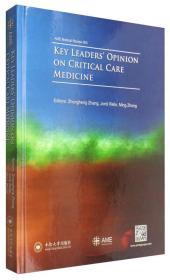
重症医学专家评论(英文)
¥ 51 1.5折 ¥ 350 全新
库存77件
河北保定
认证卖家担保交易快速发货售后保障
作者Zhongheng Zhang,【西】 Jordi Rello,Ming Zhong(章仲恒) 编
出版社中南大学出版社
出版时间2016-12
版次1
装帧精装
货号9787548724698
上书时间2024-12-15
- 在售商品 暂无
- 平均发货时间 27小时
- 好评率 暂无
- 最新上架
商品详情
- 品相描述:全新
图书标准信息
- 作者 Zhongheng Zhang,【西】 Jordi Rello,Ming Zhong(章仲恒) 编
- 出版社 中南大学出版社
- 出版时间 2016-12
- 版次 1
- ISBN 9787548724698
- 定价 350.00元
- 装帧 精装
- 开本 16开
- 纸张 胶版纸
- 页数 158页
- 字数 361千字
- 正文语种 英语
- 【内容简介】
-
Clinical management, education and research: a new must for modern intensive care physician!
The Key Leaders' Opinion on Critical Care Medicine (AME Medical Review Series 003), with Drs. Zhongheng Zhang (Jinhua municipal central hospital), Dr. jordi Rello (Vall d'Hebron University Hospital) and Ming Zhong (Zhongshan Hospital) as Editors of the book, focuses on mechanical ventilation, sepsis and infection, carcliac arrest and cardiopulmonary resuscitation, extracorporeal support, delirium and sedation, outcome of the critically ill patient, and methodology of study design. Clinical management, education and training as well as research must be considered for optimizing the overall treatment of criticallyill patients. These topics are ofparticular relevance not only in providing updated information but also to support clinicians in developing educational and training strategies as well as better interpretation and design of experimental and clinical studies. The First section of the book is about mechanical ventilation. The most challenging pulmonary disease in critically ill patients is Acute Respiratory Distress Syndrome (ARDS), and its definition is relevant to improve individualization of treatment and future study design. Mechanical ventilation plays a relevant role in patients not only admitted to Intensive Care Unit, but also in the surgical and medical wards as well as out-of- the hospital. Non-invasive respiratory assistance is more commonly used but recent data provided new information about appropr/ate selection of patients and new available techniques. Protective mechanical ventilation has been proposed initially to improve outcome in patients with ARDS. However, recent large observational and randomized clinical trials showed that protective mechanical ventilation with low tidal volume and inspiratory pressures is also useful to reduce complications and improve survival in patients without ARDS, even those undergoing high risk surgery. The second section is focusing on sepsis and infection. New definition of sepsis has been recendy proposed and largely discussed in the present book. Most importantly, it has been developed the concept that prevention is better than cure, when possible. In other words, early monitoring of sepsis may provide adequate treatment and clinical management avoiding possible severe complications, associated with poor survival. Further, the diagnosis and management of sepsis and septic shock includes the control of fever, optimization of antibiotic treatment, prevention of catheter related infections, hospital acquired pneumonia, as well as new monitoring techniques like those on microarculation monitoring. The optimal hemodynamic management with a rationale choice for fluid management is also discussed in this part of the book. The third section is dedicated to cardiac arrest and cardiopulmonary resuscitation, focusing on optimization of chest compressions, as well as target temperature management. Delirium and sedation as well as outcome of critically ill patients are discussed in the fourth and fifth section. It has been recently pointed out that the goal of intensive care is not only to provide assistance in the acute phase of the disease but also to result in an acceptable good quality of life after discharge of the hospital and at home, avoiding the occurrence of so called "disabled patient". This discussion has also relevant ethical consequences, with differences between countries to countries. Control of delirium, as well as pain and agitation, which are specifically discussed, play a major role to improve outcome and quality of life of critically ill patients. The sixth section is dedicated to extracorporeal support, which is more commonly used not only in cardiac intensive care but also for providing organ support in patients with respiratory or renal failure. Finally, the seventh section is about the methodology of study design. Scientific medical literature is dramatically growing in these last years. This is markedly important from an educational point of view since it is now recommended that research and correct interpretation and discussion of papers published become part of the education and training of the modern intensive care physician. In conclusion, this book provides new updated information about debate on clinicaJ management of critically ill patients, which is becoming interdisciplinary, and requiring specific knowledge in different areas of medicine and surgery. - 【目录】
-
Preface
i Paolo Pelosi
ii Claude Guerin
iii Zhongheng Zhang
iv Jordi Rello
v Ming Zhong
Mechanical Ventilation
Supporting respiratory function in the immunocompromised criOcally ill paaent: new perspectives for an old paradigm
New puzzles for the use of non-invasrve ventilation for immunosuppressed patients
Non-invasive ventilat:ion in immunocompromised patients with acute hypoxemic respiratory failure
Conservative versus liberal oxygenation targets for mecharucally ventilated patients-a pilot multicenter randomized controlled trial
Permissive hypoxemia/conservative oxygenation strategy: Dr.Jekyll or Mr. Hyde?
From Berlin to Kigali: the sobering journey of acute respiratory distress syndrome
The Kigali modification of the berlin definition: a new epidemiological tool for ARDS?
Acetazolamide use in severe COPD exacerbaaons requmnginvasive mecharucalventilation:impact on duration of mecharucal ventilation
Intraoperative mechanical ventilation in patients with non-injured lungs: time to talk about tailored protective ventilation?
One more brick in the wall of protective ventilation in surgical patients
"Open the lung and keep it open": a homogeneously ventilated lung is a 'healthy lung'
How to improve assessment of balance in baseline characteristics of clinical trial participants-example from PROSEVA trial data?
Quantification oflung recruitment by respiratory mechanics and CT imaging: what are the clinical implications?
Sepsis and Infection
Cardiac Arrest and CPR
Outcome for the Critically ill
Delirium and Sedation
Extracorporeal Support
Methodology of Study Design
点击展开
点击收起
相关推荐
— 没有更多了 —


















以下为对购买帮助不大的评价